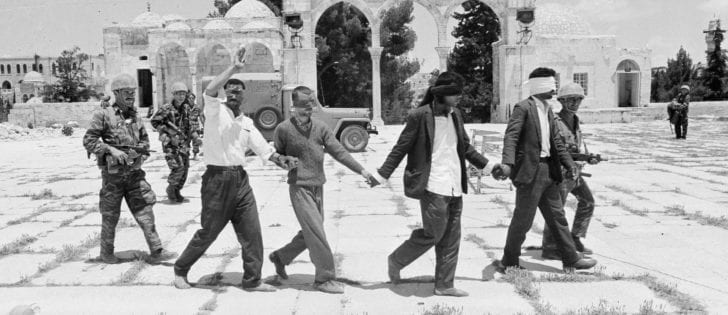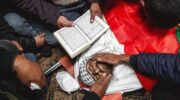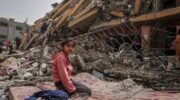Ha’aretz’s correspondent covered the story of the city’s unification after the Six-Day War. Fifty years later he revisits the dramatic decision that changed the face of the Middle East. He reports that this critical act, which for 50 years has prevented peace, was not a result of strategic planning or motivated by existential national need…
By Uzi Benziman, reposted from Israel’s Ha’aretz newspaper
The office of Interior Minister Haim-Moshe Shapira was crammed to bursting. A buzz of emotion rose from the officials, public figures, and politicians who packed the room. Teddy Kollek, Jerusalem, was one of the few who kept his cool. As Shapira (National Religious Party), his voice trembling, read out the laconic declaration that applied Israeli law, jurisdiction, and administration to the municipal area of Jerusalem (without explicitly naming the city), soft sounds of sobbing filled the room. Those present felt that they were witnessing a historical event in which Israel’s hold in East Jerusalem was being carved in stone for all time. The date was June 28, 1967 – three weeks after the Israel Defense Forces had captured the Old City and its environs, and after the government’s decision to annex the conquered territory to Israel.
There was something ironic about the fact that the task of implementing the formal act of unifying the two parts of the city fell to Shapira. He had been one of the few ministers who had objected to the decision to send the IDF into East Jerusalem and to the subsequent annexation. In a cabinet meeting held in the Knesset’s basement on June 7, two days after the start of the war, Shapira warned that Israel’s capture of the Old City would generate international pressure to internationalize East Jerusalem and that he would support this. Education Minister Zalman Aran (Alignment) added, “If the Old City is captured, when will it be returned, and to whom? I support internationalization.”
Aran expressed himself even more adamantly against a hasty annexation in a cabinet meeting held four days later. He also recalled the declaration by then-Prime Minister David Ben-Gurion at the conclusion of the Sinai Campaign in 1956. Ben-Gurion had asserted that Israel did not intend to withdraw from the territory of the Sinai Peninsula which it had captured (“Yodfat,” he said, referring to an ancient Jewish kingdom, “known as Tiran, will be part of the Third Jewish Commonwealth”), but was soon forced to reverse himself under American-Soviet pressure. Police Minister Eliyahu Sasson (Labor Alignment) also objected to the idea of an Israeli decision of principle regarding the future of the Old City. Two ministers from the left-wing Mapam party, Mordechai Bentov and Yisrael Barzilai (housing and health, respectively), recommended that the government first define the goals of peace and not be in a rush about Jerusalem. But the majority of the cabinet supported Prime Minister Levi Eshkol (Alignment), who along with Menachem Begin (Gahal) and Yigal Allon (Alignment) demanded annexation.
I knew nothing about any of this in the interior minister’s office that day. It was not until five years later that I became aware of the covert aspect of the discussions about the conquest and unification of the city when I researched the decision-making process concerning Jerusalem for my book “Jerusalem: City Without a Wall” (1973; Hebrew). What I discovered was that the decision to capture East Jerusalem, and certainly to annex it, was not motivated by an existential need (in contrast to the Six-Day War, which was launched to remove an existential threat to Israel) or by a salient security need (in contrast to the decision to invade the West Bank). The IDF was sent into the Old City primarily for emotional reasons, and because of a personal need to settle accounts with history felt by a few Israeli leaders in 1967, deriving from the role they had played in the 1948 War of Independence.
In other words, the dramatic, critical act of unifying Jerusalem, which for 50 years has constituted an impassable barrier to every attempt to solve the Israeli-Palestinian conflict, was not a result of strategic planning and was not carried out in pursuit of an existential national need, calculated long-term interests or even a vital security constraint. No. Jerusalem was unified in the wake of a storm of emotions, not to say a tempest of caprices, that took hold of a small number of decision-makers in the government and the IDF, and drove them to transform radically the situation in the Middle East.
This is not to say that the decision-makers were not aware of the fateful consequences of the steps they were taking. They were very conscious of the implications and apprehensive about the possible impact. But they yielded to the tsunami of enthusiasm that was unleashed by the air force’s tremendous military triumph in the first hours of the war, and to a thrust for revenge and a desire to take advantage of the opportunity created by the foolish and infuriating behavior of Jordan’s King Hussein, who had joined the fight despite receiving assurances from Eshkol that if Jordan kept out of the hostilities, Israel would not attack it. Accordingly, the legislative process that brought about the city’s unification was conducted in coded language, in order to keep that act hidden from the international community. The annexation directive was integrated into an obscure statutory text and was not set forth in a special law. Similarly, the Knesset procedure bore an extremely low public profile – though, even so, the chamber was packed and an exultant atmosphere was palpable in the corridors. The parties represented in parliament united almost universally behind the move. Only the two communist parties were opposed, and the Free Center party (an offshoot of Gahal) abstained. Peace activist MK Uri Avnery voted in favor.

The event in the interior minister’s office was the tail end of a process that began at midday on June 5, when Minister of Labor Yigal Allon, accompanied by Minister without Portfolio Menachem Begin, entered the office of the prime minister in Tel Aviv and told him, “Eshkol: Begin and I want Jerusalem.” The prime minister tapped his brow and replied, “Es iz a gedank” (Yiddish: “That’s an idea”). A bit earlier, Begin had shared with Eshkol’s military adviser, former chief of staff Yigael Yadin, his idea of beginning immediate discussions on the “redemption of Jerusalem.” Yadin promised to talk to Eshkol. Begin also approached Allon, who was excited by the initiative, and suggested to Begin that the two of them go to Eshkol forthwith.
Each of the three proponents of the plan had harbored psychological wounds since Israel was forced to forgo the capture of the Old City in the War of Independence. On May 18, 1948 – the day on which the Israeli assault on the Old City’s walls failed – Yadin was the IDF’s chief operations officer, Allon was the commander of the Palmach, which was assigned to execute the mission, and Begin, as commander of the Irgun underground force, was making great efforts to assist the Jews who were under siege in the Old City. Nineteen years later, the Jordanian attack on West Jerusalem provided the three with a rare chance to compensate themselves for the frustrations of the past.
Eshkol, too, had every reason to accede to the initiative: During the three-week waiting period that preceded June 5, 1967, he was perceived as an ineffectual leader who lacked the personal fortitude needed to cope with the grim security challenged posed by the Egyptian president, Gamal Abdel Nasser. Eshkol could rehabilitate his image by being at the forefront of an operation that would restore the Western Wall to the Jewish people and bring the entire Old City under Israeli rule.
Subsequently, the politicians and army officers who were involved in the move that led to Jerusalem’s unification made every effort to engrave their key role in the process upon the public’s consciousness. Yehiel Kadishai, Begin’s faithful personal secretary, always cited with pride the part played by his mentor in setting the process in motion. Yigal Allon was also at pains to play up his role. Eshkol’s biographer Yossi Goldstein presents him as being instrumental in the events, particularly in the light of the hesitations displayed by some ministers. And in his autobiography, Moshe Dayan, the defense minister at the time, also describes his major role vis-a-vis the annexation of Jerusalem, often in opposition to all the other members of the cabinet.
The army officers involved were also not inclined to modesty. The autobiography of Uzi Narkiss, who was head of Central Command in 1967, is studded with dozens of mentions of the leading role he played, in his perception, in the IDF thrust into the Old City and the Temple Mount – 19 years after he had commanded the force that failed to reach the Old City’s Jewish Quarter in 1948. Mordechai Gur, who was the commander of the Paratroops’ 55th Brigade (and later chief of staff), which was the first Israeli force to reach the Western Wall, afterward proudly styled himself the liberator of Jerusalem. Rabbi Shlomo Goren, the IDF’s chief rabbi at the time (and later Israel’s Ashkenazi chief rabbi), filed in the State Archives diary extracts of messages he sent to his staff, including emotional descriptions of his pioneering role in linking up with the paratroopers who were the first to reach the Western Wall and the Temple Mount, as he carried a Torah scroll and a shofar. As he ran, Goren noted, his mind was racing with halakhic rules about access to the holy places.
The country’s civilian and military leaders were not alone in believing that they were privileged to be present at a unique historic moment. The same feeling resonated among Israel’s entire Jewish public. When Justice Minister Yaakov-Shimshon Shapira (Alignment) visited the Western Wall, on the afternoon of June 7, he encountered cries of, “If you return the Wall, your blood is on your own head.” The mass adulation of Moshe Dayan for his part in the liberation of Jerusalem erupted in the form of ecstatic applause and cheering when the defense minister paid his first visit to the Temple Mount, on June 17. Even Haaretz titled its editorial about the capture of Jerusalem, “Shout for joy, you who dwell in Zion” (Isaiah 12:6). “Words cannot express the depth of our feelings at this time,” the editorial stated. “Jerusalem is no longer divided but is unified under the Israeli flag The Old City of Jerusalem is ours. Its gates are open. No longer will the Western Wall stand deserted and silent.”
‘The hour of revenge’
The fraught emotions of the Jewish public and its leaders were redirected toward the stunned Arab population, which suddenly had to cope with the Israeli presence. So taken aback was the Arab (who only later would define themselves as Palestinians) public in East Jerusalem by the abrupt change in its situation, that when municipal employees there saw warplanes flying over the Augusta Victoria hospital compound on Mount Scopus, some thought they were Iraqi air force planes come to the aid of the Jordanian forces.

On the morning of June 4, 1967, the Damascus Gate plaza outside the Old City was even more crowded than usual. In addition to the usual colorful melee, a demonstration of support was held for the Egyptian-Jordanian defense agreement that had been signed five days earlier, placing the Jordanian army under the command of Egypt’s chief of staff, General Abdul Munim Riad. The atmosphere in East Jerusalem was one of jubilant expectation of the moment of revenge on Israel and the erasure of the shame of the defeat in 1948. On June 2, Ahmad Shukeiri, chairman of the Palestine Liberation Organization, received an ardent welcome at the Al-Aqsa Mosque in Jerusalem after he delivered a militant speech in which he promised the Arab residents that they would soon be able to return to their homes in the western part of the city. The battle cries were not accompanied by practical preparations for war: an infrastructure for civilian defense barely existed in East Jerusalem. Only the blacking out of car headlights and the beefing up of Jordanian army positions suggested that a war loomed. Not one public bomb shelter existed.
On June 5, at 9 A.M., the East Jerusalem population heard Radio Cairo announce, “The Egyptian army is victorious! The Zionist enemy is being crushed! The hour of revenge has arrived!” An hour and forty-five minutes later, the Jordanian forces began to take that revenge. They captured Government House (headquarters of the United Nations), shelled West Jerusalem, and announced that they had taken Mount Scopus (which had been an Israeli enclave). The 520 municipality employees continued working, gripped by tremors of anticipation. Like everyone else in East Jerusalem, they knew nothing about the eradication of the Egyptian and Syrian air forces and about the Israeli counter-response to the Jordanian shelling.
The afternoon brought a change in their mood. The decisive proof of the Arab victory had not arrived. For a whole day and night, city employees waited in their offices with mounting concern. The next morning they slipped out to their homes, one by one. The district office in the Wadi Joz neighborhood, adjacent to the Old City, reported that Israeli paratroopers were advancing in its direction.
Anwar al-Khatib, the governor of Jerusalem on behalf of the Jordanian government, was the first to experience the shock of disillusionment. He was taken to the Ambassador Hotel in East Jerusalem to meet with Maj. Gen. Chaim Herzog, who had been appointed military governor of East Jerusalem and the West Bank. Al-Khatib, frightened to death and obsequious, told Herzog that the Jordanian army was at fault for having opened fire from the Temple Mount. Tearfully, he added that when Israeli troops entered his home in the East Jerusalem neighborhood of Beit Hanina, he feared that death was imminent, but to his surprise, the soldiers had behaved in a civilized manner. He requested permission to travel to Amman “in order to persuade King Hussein to reach a settlement with Israel.” He also asked the Israelis to allow a few families to be united with their elder members, who were in Amman.
Herzog agreed and leveraged the request into a broad Israeli initiative: From June 11, buses to the Jordan River bridges were placed at the disposal of the Arab public in Jerusalem. The passengers were required to sign a document stating that they were leaving the city of their own will. Few people took advantage of the offer; having learned the lesson of 1948, the residents of East Jerusalem clung to their city.
Ruhi al-Khatib (no relation to Anwar), the mayor of East Jerusalem, also found himself in a bind. He had to demarcate the scale of his cooperation with the Israeli occupation authorities without being perceived as a traitor, either in his own eyes or those of Jerusalemites. On June 10, he accompanied Aharon Layish, a Middle Eastern affairs expert from the Hebrew University of Jerusalem, who was seconded to the Military Government as liaison officer to the leadership of the occupied city, on a tour of the local markets in an effort to encourage merchants to open their businesses. The positive response was quick. The two also visited the local electric company and municipal water facility, and al-Khatib ordered them to operate normally. He then asked Layish to allow him to convene the municipal council in order to get backing for his decisions.
On June 5, Minister of Labor Yigal Allon, accompanied by Minister without Portfolio Menachem Begin, entered the office of the prime minister in Tel Aviv and told him, ‘Eshkol, Begin and I want Jerusalem.’
The council met on June 13 and issued a statement calling on the city’s residents to lay down their arms and maintain order. He reported to the population on the council’s efforts, in conjunction with the Military Government, to restore regular life as soon as possible. A similar statement was issued by the chamber of commerce.
This delicate balance of relationships came to an abrupt end a few days later, when Col. Shlomo Lahat (later the mayor of Tel Aviv) was appointed military governor of Jerusalem and treated the two al-Khatibs in a brusque manner that they found offensive. Subsequently, they discovered that Teddy Kollek’s pleasant demeanor concealed his intention to take control of the eastern city and remove them from office. Ruhi al-Khatib rejected outright Lahat’s suggestion to merge the municipal councils of the two parts of the city. On June 29, the 12 members of the East Jerusalem municipal council were summoned by the Israeli Military Police to their own city hall. Only five showed up. The building was locked, and they were sent to the nearby Gloria Hotel, where Lahat’s deputy, Lt. Col. Yaakov Salman, read out to them a document he had scribbled shortly before, announcing the dissolution of the council and the termination of their service. When Ruhi al-Khatib asked for written confirmation, David Farhi, an officer in the Military Government who was instrumental in shaping the defense minister’s approach to the Arab population and its leadership, translated the document into Arabic on a napkin bearing the hotel’s logo. The validity of this makeshift procedure was never put to a legal test.
Israel tried to fill the vacuum left by the absence of a council in two ways: by attempting to persuade a few dismissed councilmen to join the Israeli municipal council as private individuals; and by proposing creation of a recognized representation of public figures – including representatives of the churches and of the Muslim residents, among them Ruhi al-Khatib – and integrating them as a group into the Israeli council. Both suggestions were rejected out of hand.

Whereas the civil leadership in East Jerusalem tread carefully in its dealings with the Israeli authorities, the religious leadership was bolder. On July 24, 1967, the head of the Sharia Court, Sheikh Abd al-Hamid a-Sayekh, secretly convened his colleagues and induced them to sign a long, reasoned petition expressing opposition to the occupation and annexation and defying the moves by the Israeli Ministry of Religious Affairs to take control of the religious institutions in East Jerusalem. A-Sayekh’s move came as a total surprise to Israeli intelligence and to the military government. They thought that the response of the Arab population in Jerusalem to the situation would be no different from that of the Arabs who remained in Israel after 1948. The Israel leadership discovered, to its amazement, buds of revolt in the population that was conquered in 1967. The word “revolt” still appears in quotation marks in documents dealing with the situation a month after the annexation.
A-Sayekh turned out to be a tough adversary. He established the Committee for National Guidance, which included well-known figures from East Jerusalem’s previous leaders who were loyal to Jordan, and led them to initiate controlled expressions of rebellion. These actions were coordinated with Amman. The committee strove to thwart the efforts of the Israeli authorities to convey the impression that life in East Jerusalem was back to normal. In practical terms, the committee called for strikes and organized acts of civil resistance (demonstrations, petitions) that encompassed all segments of the population. The Israeli reaction was not long in coming: On September 22, 1967, Sheikh a-Sayekh was deported to Jordan.
His place as head of the Committee for National Guidance was taken by Ruhi al-Khatib – who was deported to Jordan half a year later. The public leaders in East Jerusalem were unsuccessful in coping with the Israeli administration as it tightened its hold in the city and sought to accustom the local residents to its presence. The Arab leadership, both civil and religious, tried by various nonviolent means to stir up the population, inform the world about their plight under occupation, and hamper Israel’s efforts to maintain routine administration in the city. But to no avail. They faced a powerful Israeli ruling force, with high-quality intelligence and a determination to break Arab attempts at resistance.
Wavering between conflicting pressures – expectations harbored by the Jordanian authorities, involvement of the Arab Communist Party, specific interests of the religious leadership, the tension between the needs of East Jerusalem residents and the population of the West Bank, and above all the authority of the Israel administration and its ability to harm local leaders personally – the East Jerusalem leadership failed to organize an effective civil revolt. That lacuna began to be filled by armed underground groups.
‘No comparison’
Not long after the annexation of East Jerusalem, the journalist Amos Elon and I met with Maj. Gen. Uzi Narkiss at Central Command headquarters. Elon asked him how long it would be, in his opinion, before the occupation and the annexation spawned seeds of revolt. Narkiss relaxed in his chair and said complacently, “I was the IDF attache in Paris during the revolt of the FLN [National Liberation Front] against French rule in Algeria. There is no comparison between the Arabs of Jerusalem and the West Bank and the Algerian Arabs. There will be no armed resistance here.”
Early in October 1967, a few weeks after our meeting with Narkiss, Anam Barnawi, her sister Fatma and Omar Odeh entered the Zion movie theater in central Jerusalem and placed a booby-trapped bag under a seat in row 25. As the three left, they aroused the suspicion of a moviegoer. A policeman was summoned. He picked up the bag and ran with it to a nearby lot, where he placed it on the ground. A few minutes later it exploded. The violent Arab revolt against the occupation and annexation had begun.
Part 2 of this article will appear on June 2.
Uzi Benziman is a historian and analyst – specializing in tracing Ariel Sharon’s biography
RELATED READING:
- Israel Approves The Illegal Annexation of Palestinian Lands Near Ramallah
- Israeli High Court: Palestinian homes “too close to the wall, must be demolished”
- Can you say “Israeli apartheid”? 200 Jewish-only communities approved
- Merry Christmas, Israel is building 2,191 new settlement housing units on Palestinian land
- Israel’s New Nation-State Law: Codifying Apartheid – Podcast interview with Alison Weir





